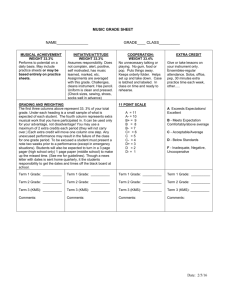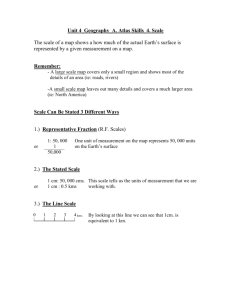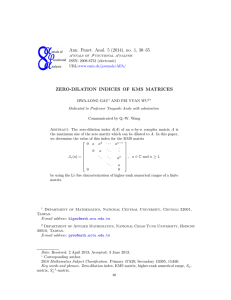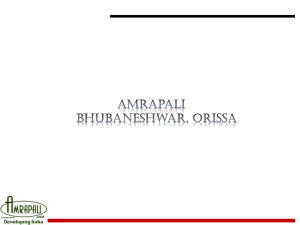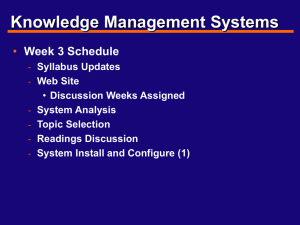FROM ANALOG TO DIGITAL AERIAL IMAGEPRODUCTION.
advertisement
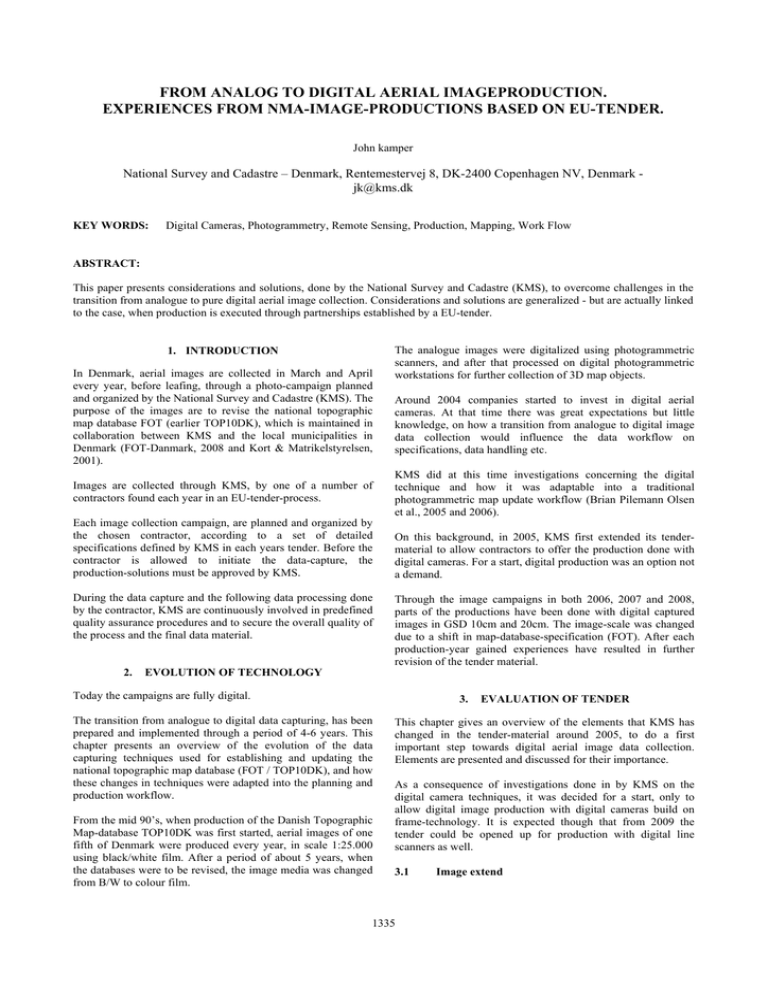
FROM ANALOG TO DIGITAL AERIAL IMAGEPRODUCTION. EXPERIENCES FROM NMA-IMAGE-PRODUCTIONS BASED ON EU-TENDER. John kamper National Survey and Cadastre – Denmark, Rentemestervej 8, DK-2400 Copenhagen NV, Denmark jk@kms.dk KEY WORDS: ………………… Digital Cameras, Photogrammetry, Remote Sensing, Production, Mapping, Work Flow ABSTRACT: This paper presents considerations and solutions, done by the National Survey and Cadastre (KMS), to overcome challenges in the transition from analogue to pure digital aerial image collection. Considerations and solutions are generalized - but are actually linked to the case, when production is executed through partnerships established by a EU-tender. 1. INTRODUCTION In Denmark, aerial images are collected in March and April every year, before leafing, through a photo-campaign planned and organized by the National Survey and Cadastre (KMS). The purpose of the images are to revise the national topographic map database FOT (earlier TOP10DK), which is maintained in collaboration between KMS and the local municipalities in Denmark (FOT-Danmark, 2008 and Kort & Matrikelstyrelsen, 2001). Images are collected through KMS, by one of a number of contractors found each year in an EU-tender-process. Each image collection campaign, are planned and organized by the chosen contractor, according to a set of detailed specifications defined by KMS in each years tender. Before the contractor is allowed to initiate the data-capture, the production-solutions must be approved by KMS. During the data capture and the following data processing done by the contractor, KMS are continuously involved in predefined quality assurance procedures and to secure the overall quality of the process and the final data material. 2. The analogue images were digitalized using photogrammetric scanners, and after that processed on digital photogrammetric workstations for further collection of 3D map objects. Around 2004 companies started to invest in digital aerial cameras. At that time there was great expectations but little knowledge, on how a transition from analogue to digital image data collection would influence the data workflow on specifications, data handling etc. KMS did at this time investigations concerning the digital technique and how it was adaptable into a traditional photogrammetric map update workflow (Brian Pilemann Olsen et al., 2005 and 2006). On this background, in 2005, KMS first extended its tendermaterial to allow contractors to offer the production done with digital cameras. For a start, digital production was an option not a demand. Through the image campaigns in both 2006, 2007 and 2008, parts of the productions have been done with digital captured images in GSD 10cm and 20cm. The image-scale was changed due to a shift in map-database-specification (FOT). After each production-year gained experiences have resulted in further revision of the tender material. EVOLUTION OF TECHNOLOGY Today the campaigns are fully digital. 3. The transition from analogue to digital data capturing, has been prepared and implemented through a period of 4-6 years. This chapter presents an overview of the evolution of the data capturing techniques used for establishing and updating the national topographic map database (FOT / TOP10DK), and how these changes in techniques were adapted into the planning and production workflow. From the mid 90’s, when production of the Danish Topographic Map-database TOP10DK was first started, aerial images of one fifth of Denmark were produced every year, in scale 1:25.000 using black/white film. After a period of about 5 years, when the databases were to be revised, the image media was changed from B/W to colour film. EVALUATION OF TENDER This chapter gives an overview of the elements that KMS has changed in the tender-material around 2005, to do a first important step towards digital aerial image data collection. Elements are presented and discussed for their importance. As a consequence of investigations done in by KMS on the digital camera techniques, it was decided for a start, only to allow digital image production with digital cameras build on frame-technology. It is expected though that from 2009 the tender could be opened up for production with digital line scanners as well. 3.1 1335 Image extend The International Archives of the Photogrammetry, Remote Sensing and Spatial Information Sciences. Vol. XXXVII. Part B4. Beijing 2008 A basic-point to define a traditional analogue photo campaign, is the camera frame or the image-extend, meaning the resulting area on the ground that is covered through one image by the analogue camera. All “full size” analogue aerial cameras use the same frame size, defined by the film size of 23cm by 23cm, and by that also represent the same image-extend on the ground - given a specific camera lens system (focal length) and a specific flying height. This is not the case for the digital cameras, where CCD’s has substituted the traditional film-media. There are big differences on how the cameras CCD’s are combined and arranged into the final image-frame. And by this, also different resulting imageextends. 3.4 Summary At KMS, the first revision of the tender material to adapt a digital production, resulted in exclusion of all references of image extends, camera lens system, flying height and image scale. Instead the GSD “ground sampling distance” was introduced and substituted to describe matters where the excluded specifications were used. These matters do in some ways simplify the tender, by focussing on only GSD as the primary specification of a photo campaign. But other parts, as missing continuity in technology, image positioning and image extend (by different camera-types) could cause a more complicated tender evaluation and production QA. In table 1 is shown an overview of these discussed elements. Because there is no exact conversion from one single analogue image-extend to the various digital CCD frame image-extends. The term image-extend is no longer used in the specification for a KMS digital photo campaign. Subject Image extent 3.2 Image scale / GSD Coverage Flying height Image-scale / Flying height For an analogue photo-campaign, it is also necessary to define the two interacting parameters image-scale and flying-height. Image-scale is the most commonly used and exact term, which through a predefined camera-lens-system (and image-extend), also specifies the exact flying height. For a digital image campaign, image-scale and flying-height are also interconnected and by so it is only needed to specify one of them. The image-scale specification for digital cameras, are the definition of “ground sampling distance” (GSD). The GSD defines what size on the ground that has to be represented in one pixel. Normally the GSD are specified as “X centimetres” meaning that one image pixel (must) represent “X centimetres by X centimetres” on the ground (flat ground). Specification of GSD is sufficient and preferable to substitute the traditionally definition of both image-scale and flyingheight. Using the GSD, the specification is neutral to which digital camera could be used. Different cameras with different camera-lens parameters will adapt the requested GSD, by doing the data-collection from different flying heights. 3.3 Coverage / Flight lines By the fact that the different digital cameras consist of different image extents, the cameras do also cover various areas on the ground, given a specific GSD. This is also the case when compared to an analogue camera. A transition from analogue to digital image campaigns, or “year by year” transitions between digital camera types, will therefore cause ongoing fluctuations in “ground coverage” on images and by that also fluctuations in “number of images and number of flight-lines” needed to cover a specified image-campaign. When the production, as for KMS, is highly repetitive and based on tenders with possible changing contractors, the image footprint and number of images for each campaign are very seldom constant over years. Analogue Same for all camera-types Exact for each image scale Image scale… exact Exact for each image scale Digital Differs for each camera-type Differs for each camera-type GSD…. exact Differs for each camera-type Table 1: aspects on analoug/digital camera-types 4. EVALUATION OF WORKFLOW AND END-PRODUCTS In the production workflow, the different phases of planning, tender, data collection, logistics, data processing, documentation etc. have all shown elements, where the use of the digital camera technology causes serious considerations and serious need for changes. These different workflow-phases of the digital image data collection will be discussed. Critical points and recommended practical solutions will be presented and argued. 4.1 Planning The initial revision of the KMS photo campaign tender-material, was focused on the referred matters presented in section 3. To allow data capturing with digital cameras, all references of image-extend, camera-objective, flying-height and image-scale had to be removed from the tender material and substituted with the term “ground sampling distance” (GSD). To consider, is also the effective “ground coverage” of each image, which, in case of digital production, is depending on the camera type used by the chosen contractor. Therefore a preflight planning of image positions and image frames, should no longer to be part of the tender material. The pre-planning was earlier produced and estimated by KMS. Results was given as information to the tenders, as input for there calculations and price-estimations. Planning now has to wait until the contractor and thereby the camera type has been defined. This means that each tender now have to do his own pre-planning, to estimate the necessary workload and a price. 1336 The International Archives of the Photogrammetry, Remote Sensing and Spatial Information Sciences. Vol. XXXVII. Part B4. Beijing 2008 Because the flight planning has now been fully removed to be a part of the bidder’s job and subsequently a job for the chosen contractor, KMS instead maintain and deliver a detailed specification on how planning and project-definitions must be done. Before the contractor is allowed to initiate the data-capture, the production-solutions must be approved by KMS. 4.2 Tender evaluation The KMS photo campaign tender, is an EU-tender assigned to certain specific rules regarding publication, evaluation and so forth. These rules are the same though, for both analogue and digital image production. One topic that has shown to have big influence on the process of tender-evaluation, is the number of bets that is received on a tender. The number of bets received on a digital photo campaign is, among other topics, also a question on how many companies that actually do offer a digital solution. Especially in the first years this was evident. If a tender is open for digital production only, it will probably mean that prices will be high, reflecting that there is only little competition. On the other hand, if a tender is open to both analogue and digital production, then one has to seriously consider the different weights on the evaluation criteria, on both economy and on quality. If the economy is weighted to high, it is certain that the analogue bidder’s are favoured, by not having new investments to pay, and one might be “stocked” on old technology. But if quality is weighted to high, it is likely that the price-jump from an earlier analogue production will be high, even though there might be analogue and cheaper bets in the tender as well. By tuning the evaluation criteria’s in the tender, year by year, one might keep influence on operating the photo campaign, in a world of changing accessibility to old and new technical production systems. Another topic is that the evaluation of the tender has shown to be more complicated to handle than before. This is basically because a digital solution differs more compared to both analogue and also to other digital solutions, than it did before. When comparing each solution on technology, methodology and logistics and quality assessments. 4.3 Data capture The digital data capture, as for the analogue, is produced by the contractor, including only informative communication to the customer on quality and progress. The digital data capture is facilitated by a possibility to do “on the fly” verification of what is logged on the camera-computer. Normally this is done solely by the contractor. Because of the digital camera-technique and optics, it has shown that even images captured in less good conditions as “high cloud cover” or “low sun angle”, can actually be used for mapping, orthoimages etc. with good results. This is also because image quality can be optimized in the image processing. This means that data capturing time can be extended to include both some “cloudy days” and also by more production hours on both ends of a photo day. On the other hand, because image extend, in the digital cameras are smaller than in the analogue cameras, a higher number of flight lines are needed to cover the same area. Camera-failures are more “unexpected” and “uncertain” in the new digital cameras, when it comes to technique and architecture, as they are still not yet as fully proven and understood. KMS has not yet conclusions on how often and how much this affect the data capture campaign. 4.4 Data logistics Data logistic is in both analogue and digital data collection in responsibility of the contractor, with only informative communication with the customer on quality and progress. The time delay from “when images are taken” until the customer has a “read-out image for QA”, is shortened dramatically. This means that the customer now “has a chance to be”, more involved in the early process of QA-dialog with the contractor. This might request more work and also some new capabilities by the costumer. But it is also a tool for optimizing the data and the forthcoming use of the data. A matter to be aware of on logistics, is the maximum possible data amount to be captured in one day. As for the analogue production one might run out of film, in the digital production one must be aware of how much disc space are available for both capturing images for a whole day, and also how much disc space and time (speed) are available for emptying the cameradata to a transport media. It is important that this does not delay the photo campaign. Especially if data has to be captured within a limited time-period. 4.5 Data processing Data processing is essential on merging the digital cameras different single CCD’s into one geometrically correct image. Software to do this is developed by the camera-producer and is derived to handle one specific camera type. While processing the merged image from the different CCDs, the contractor also set up the radiometric presentation of the image. This can include direct processing, pan sharpening and also 12 bit to 8 bit image conversion. The different cameratypes uses different techniques and different user interfaces for these processes. And therefore reflect an “camera-specific methodology”. Actually one has to rely completely on the producers skills and experiences with the software. Many important aspect of the image presentation are included in the image-processing. And the processing is often managed or presented, as a “black box”. Therefore the conclusion in KMS is, that this is a very important topic, which KMS will focus on in the future. Until now experiences are that, in general it is not very easy to interact with the producers, during this process. 4.6 Data volume By analogue aerial image campaigns, the images were traditionally exposed on either colour or black/white film. For 1337 The International Archives of the Photogrammetry, Remote Sensing and Spatial Information Sciences. Vol. XXXVII. Part B4. Beijing 2008 digital use the film were afterwards scanned in a resolution that were reasonable for their intended use. The chosen scan resolution directly reflecting the data volume. “RGB”, “PAN” or “CIR”. Finally followed by the “image enter, Easting- and Northing-UTM-positions” calculated by IMU, GPS and AT. Now using digital captured data, the scanning is no longer a parameter, meaning that data are always saved in the best possible resolution. Another way to secure metadata, is to specify that metadata must be incorporated in the image files. KMS uses image files in two formats, tiff and ecw. In both cases it is possible to incorporate metadata in the file-header. It is often the case, that data are captured not only in the panchromatic band but also in red, green and blue bands, and sometimes also in the near infrared band. Because the CIR images can be produced partly parallel to the RGB images CIRdata are often offered as part of other production. Through the image-processing, data is then merged into pan sharpened RGB images or pan sharpened CIR images. It is most likely that the use of digital captured data, will keep on expanding the need of disk space dramatically. One thing to do, is to precisely consider what data are actually relevant to keep. At KMS data are normally delivered in tif-format. For daily use data are also compressed into ecw-format, but this is not an important parameter for estimating the overall disk space because the compression is very hard. Post-processed data as orthofotos is not considered in this estimate. In KMS productions, it has until now not been adequate, to save the image-data in 4-channel images (R,G,B,NIR). Instead we have been attach to the fact that software in general is not ready to handle 4-channel images. KMS keep two 3-channel images (one RGB and one CIR). Using a 4-channel image solution would clearly solve some lack of disc-space. But to take this step, it is needed that most photogrammetric software and image processing software are able to access 4-channel data. So they can be processed afterwards. 4.7 Metadata Because a data label on the images is no longer present, there is a risk that metadata for the image will loose its connection to the image. One way to solve this is by defining the Image ID in an systematic way – so that sufficient information is available within its ID. One example is to name the images as shown figure 1. But our experiences has shown that metadata in the image files are not easily read and we have also found that data in the header is often with errors. As a consequence, KMS has been working on automatic software procedures, to check the validity of metadata in image files. Results are that many errors are found in the QA-procedures, already when data are receive, and by this is corrected immediately. 4.8 End-products Even though KMS has experienced, that digital captured aerial images, in general represents images with a higher imagequality than analogue images. There are still some general errors found in the images, which is often not revealed until somebody by accident look into it. Errors are apparently not found and corrected during imageprocessing in an automatic way. Some examples are shown and commented in figure 3, 4 and 5. Images captured for KMS are being used in two different production workflows. One derived production is to use images and image orientations in photogrammetric workstations for mapping purpose. And another derived production is to use images and image-orientations, together with a DTM to produce orthoimages for administrative purposes. Both analogue and digital captured images has been used in these two KMS productive workflows. The conclusion is for both derived products, that we do not observe any differences in neither productivity nor quality, which can be by related to the use of analogue or digital derived images. 4.9 Summary The planning process for the digital image campaign has become more simple as the only technical specification that has to be decided, is a relevant ground sampling distance. This together with the fact that KMS now is having the tendercompanies to do their flight plan for the image campaign area specified. On the other hand, the tender-evaluation process has been complicated, because incoming tenders are found often to be more different in character. In general, KMS do not see any trends in having a faster or slower data capturing process for the digital image capturing. KMS experience that the weather is still the major-factor for having data captured before leafing. Figure 1: Filenames representing project- flightline- and imageID’s, image type (CIR) and UTM-coordinates (E+N in Z32N). The Image ID’s shown in figure 1 is created from “year and project identification”. Followed by a “flight-line-exposurenumber”. Next included is the identification of image-type as On the other hand data processing gives relatively fast results, so that processed data can be part of the map-production and ortophoto production, already in June. Data logistics and data processing is kind of a “black box” which is controlled solely 1338 The International Archives of the Photogrammetry, Remote Sensing and Spatial Information Sciences. Vol. XXXVII. Part B4. Beijing 2008 by the contracting company. It is planned that KMS will focus on image radiometry and image processing in the future, because we see this as a procure of high importance on the final image results. The data volume has been seen to explode, when going into digital image collection. This will to some extend be solved when software in time are ready to handle 4-channel images. But even with 4-channel images, it must be evident that working with aerial images, data volumes are and will still be huge. Regarding image metadata, this is a topic that has been focused on by KMS in resent years. This was caused by a potential risk, to end op having an image-bank containing images with no metadata (time, location etc.). We experienced that it was not an easy job to secure that metadata are available an in sufficient quality, as some companies don’t focus enough on this topic Figur 3: Image found to include pixel-errors. Images and end-products as orthophotoes and derived maps derived from digital cameras data, are found to be of generally high quality. Even though, images still end up showing some unexpected errors. REFERENCES Brian Pilemann Olsen, Thomas Knudsen, Morten Nielsen, Kristian Keller, LarsTyge Jørgensen, Poul Frederiksen. Evaluation of digital photogrammetry in an operational mapping environment, In International Archives of Photogrammetry, Remote Sensing and Spatial Information Sciences, vol. XXXVI, part 1, 2005 Brian Pilemann Olsen, Thomas Knudsen, Kristian Keller, Morten Nielsen, Rune Carbuhn Andersen, John Kamper, Lars Tyge Jørgensen og Poul Frederiksen. Digital high resolution images and their application in operational mapping Environments. In Proceedings of 7th Geomatic week, Barcelona, Spain, 2006 Figure 4: lense-flares. FOT-Danmark. FOT specifikationen. http://www.fotdanmark.dk/, May 2008. Last visit 2008-05. Kort & Matrikelstyrelsen. TOP10DK. Geometrisk registrering. Technical report, National Survey and Cadastre—Denmark, Rentemestervej 8, 2400 København NV, Denmark, maj 2001. Figur 2: Image found to be oversaturated in parts. 1339 Image found to include both sun-spots and The International Archives of the Photogrammetry, Remote Sensing and Spatial Information Sciences. Vol. XXXVII. Part B4. Beijing 2008 1340
